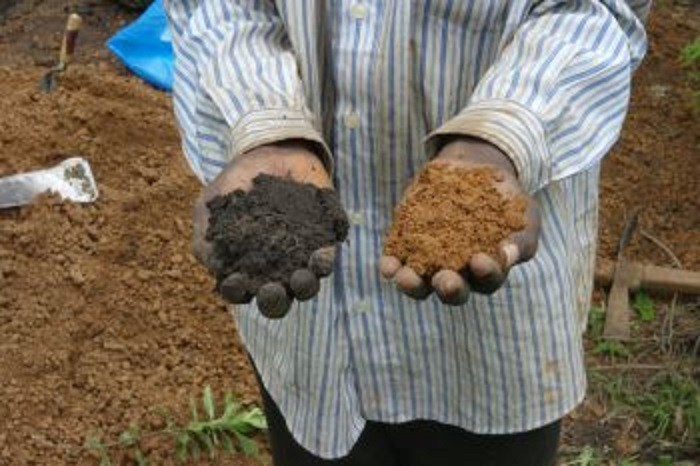A farming technique practiced for centuries by villagers in West Africa, which converts nutrient-poor rainforest soil into fertile farmland, could be the answer to mitigating climate change and revolutionizing farming across Africa.
A global study, led by the University of Sussex, which included anthropologists and soil scientists from Cornell, Accra, and Aarhus Universities and the Institute of Development Studies has for the first-time identified and analysed rich fertile soils found in Liberia and Ghana.
They discovered that the ancient West African method of adding charcoal and kitchen waste to highly weathered, nutrient poor, tropical soils can transform the land into enduringly fertile, carbon-rich black soils that the researchers dub ‘African Dark Earths’.
From analysing 150 sites in northwest Liberia and 27 sites in Ghana researchers found that these highly fertile soils contain 200-300 percent more organic carbon than other soils and are capable of supporting far more intensive farming.
Professor James Fairhead, from the University of Sussex, who initiated the study, said: “Mimicking this ancient method has the potential to transform the lives of thousands of people living in some of the most poverty and hunger stricken regions in Africa.
“More work needs to be done but this simple, effective farming practice could be an answer to major global challenges such as developing ‘climate smart’ agricultural systems that can feed growing populations and adapt to climate change.”
Similar soils created by Amazonian people in pre-Columbian eras have recently been discovered in South America – but the techniques people used to create these soils are unknown. Moreover, the activities which led to the creation of these anthropogenic soils were largely disrupted after the European conquest.
Encouragingly researchers in the West Africa study were able to live within communities as they created their fertile soils. This enabled them to learn the techniques used by the women from the indigenous communities who disposed of ash, bones and other organic waste to create the African Dark Earths.
Dr Dawit Solomon, the lead author from Cornell University, said: “What is most surprising is that in both Africa and in Amazonia, these two isolated indigenous communities living far apart in distance and time were able to achieve something that the modern-day agricultural management practices could not achieve until now.
“The discovery of this indigenous climate smart soil-management practice is extremely timely. This valuable strategy to improve soil fertility while also contributing to climate change mitigation and adaptation in Africa could become an important component of the global climate smart agricultural management strategy to achieve food security.”
Slash-and-burn method
The infamous slash-and-burn method, in which material like trees and plants are simply burned in open fires, transfers a very small percentage of carbon to the soil, releasing much of it into the atmosphere in the form of carbon dioxide. But slash-and-char, in which wet vegetation under a layer of straw is burned into charcoal, is much more efficient, transferring almost half of its carbon content into the soil.
Both slash-and-burn and slash-and-char include, you might notice, the word “slash” and involve deforestation, one of the most destructive acts for the environment. The carbon sequestration that results from slash-and-char makes it the lesser of two evils—but not “good,” exactly.
There are sustainable sources of biochar that can be had by the home gardener, if you want to use the technique without burning down the woods in back of your house. Check out this Washington State University guide for more.


1 thought on “This 700-Year-Old Farming Technique Can Make Super Fertile Soil”
pan
(February 2, 2020 - 6:25 am)Link to WSU guide does not work but this probably has the same content: https://research.libraries.wsu.edu:8443/xmlui/bitstream/handle/2376/5148/FS147E.pdf;sequence=2